Tutorial: Microsoft Entra single sign-on (SSO) integration with Genesys Cloud for Azure
In this tutorial, you'll learn how to integrate Genesys Cloud for Azure with Microsoft Entra ID. When you integrate Genesys Cloud for Azure with Microsoft Entra ID, you can:
- Control in Microsoft Entra ID who has access to Genesys Cloud for Azure.
- Enable your users to be automatically signed-in to Genesys Cloud for Azure with their Microsoft Entra accounts.
- Manage your accounts in one central location.
Prerequisites
To get started, you need the following items:
- A Microsoft Entra subscription. If you don't have one, you can get a free account.
- A Genesys Cloud for Azure single sign-on (SSO)–enabled subscription.
Scenario description
In this tutorial, you configure and test Microsoft Entra SSO in a test environment.
Genesys Cloud for Azure supports SP and IDP initiated SSO.
Genesys Cloud for Azure supports Automated user provisioning.
Note
Identifier of this application is a fixed string value so only one instance can be configured in one tenant.
Add Genesys Cloud for Azure from the gallery
To configure integration of Genesys Cloud for Azure into Microsoft Entra ID, you must add Genesys Cloud for Azure from the gallery to your list of managed SaaS apps. To do this, follow these steps:
- Sign in to the Microsoft Entra admin center as at least a Cloud Application Administrator.
- Browse to Identity > Applications > Enterprise applications > New application.
- In the Add from the gallery section, type Genesys Cloud for Azure in the search box.
- Select Genesys Cloud for Azure from the results panel and then add the app. Wait a few seconds while the app is added to your tenant.
Alternatively, you can also use the Enterprise App Configuration Wizard. In this wizard, you can add an application to your tenant, add users/groups to the app, assign roles, as well as walk through the SSO configuration as well. Learn more about Microsoft 365 wizards.
Configure and test Microsoft Entra SSO for Genesys Cloud for Azure
Configure and test Microsoft Entra SSO with Genesys Cloud for Azure using a test user named B.Simon. For SSO to work, you must establish a link relationship between a Microsoft Entra user and the related user in Genesys Cloud for Azure.
To configure and test Microsoft Entra SSO with Genesys Cloud for Azure, perform the following steps:
- Configure Microsoft Entra SSO to enable your users to use this feature.
- Create a Microsoft Entra test user to test Microsoft Entra single sign-on with B.Simon.
- Assign the Microsoft Entra test user to enable B.Simon to use Microsoft Entra single sign-on.
- Configure Genesys Cloud for Azure SSO to configure the single sign-on settings on application side.
- Create Genesys Cloud for Azure test user to have a counterpart of B.Simon in Genesys Cloud for Azure that's linked to the Microsoft Entra representation of user.
- Test SSO to verify whether the configuration works.
Configure Microsoft Entra SSO
To enable Microsoft Entra SSO in the Azure portal, follow these steps:
Sign in to the Microsoft Entra admin center as at least a Cloud Application Administrator.
Browse to Identity > Applications > Enterprise applications > Genesys Cloud for Azure application integration page, find the Manage section and select single sign-on.
On the Select a Single Sign-On method page, select SAML.
On the Set up Single Sign-On with SAML page, select the pencil icon for Basic SAML Configuration to edit the settings.
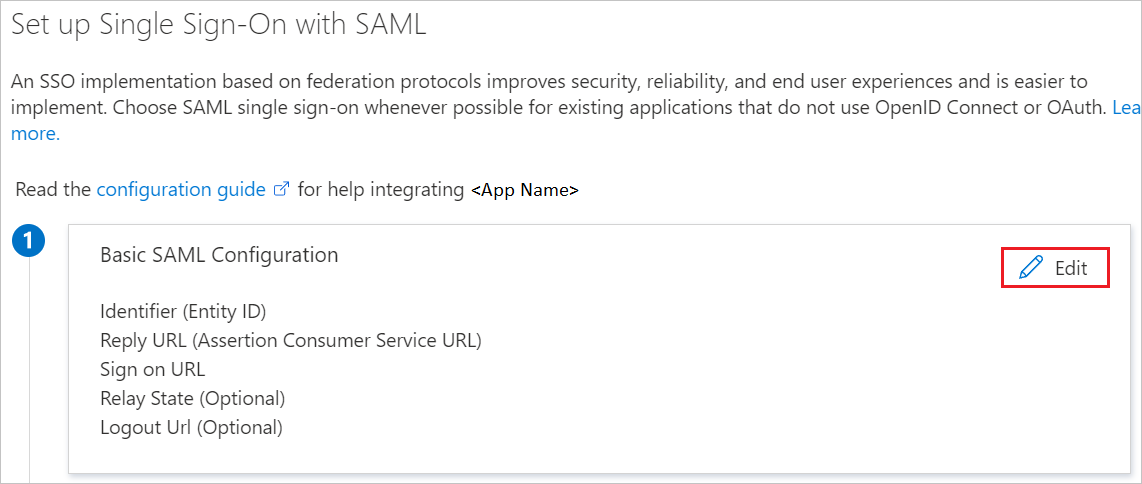
In the Basic SAML Configuration section, if you want to configure the application in IDP-initiated mode, perform the following steps:
a. In the Identifier box, enter the URLs that corresponds to your region:
Identifier URL https://login.mypurecloud.com/saml https://login.mypurecloud.de/saml https://login.mypurecloud.jp/saml https://login.mypurecloud.ie/saml https://login.mypurecloud.com.au/saml b. In the Reply URL box, enter the URLs that corresponds to your region:
Reply URL https://login.mypurecloud.com/saml https://login.mypurecloud.de/saml https://login.mypurecloud.jp/saml https://login.mypurecloud.ie/saml https://login.mypurecloud.com.au/saml Select Set additional URLs and take the following step if you want to configure the application in SP initiated mode:
In the Sign-on URL box, enter the URLs that corresponds to your region:
Sign-on URL https://login.mypurecloud.com https://login.mypurecloud.de https://login.mypurecloud.jp https://login.mypurecloud.ie https://login.mypurecloud.com.au Genesys Cloud for Azure application expects the SAML assertions in a specific format, which requires you to add custom attribute mappings to your SAML token attributes configuration. The following screenshot shows the list of default attributes:

Additionally, Genesys Cloud for Azure application expects a few more attributes to be passed back in the SAML response, as shown in the following table. These attributes are also pre-populated, but you can review them as needed.
Name Source attribute Email user.userprincipalname OrganizationName Your organization nameOn the Set up Single Sign-On with SAML page, in the SAML Signing Certificate section, find Certificate (Base64) and select Download to download the certificate and save it on your computer.

In the Set up Genesys Cloud for Azure section, copy the appropriate URL (or URLs), based on your requirements.

Create a Microsoft Entra test user
In this section, you'll create a test user named B.Simon in the Azure portal:
- Sign in to the Microsoft Entra admin center as at least a User Administrator.
- Browse to Identity > Users > All users.
- Select New user > Create new user, at the top of the screen.
- In the User properties, follow these steps:
- In the Display name field, enter
B.Simon. - In the User principal name field, enter the username@companydomain.extension. For example,
B.Simon@contoso.com. - Select the Show password check box, and then write down the value that's displayed in the Password box.
- Select Review + create.
- In the Display name field, enter
- Select Create.
Assign the Microsoft Entra test user
In this section, you'll enable B.Simon to use single sign-on by granting access to Genesys Cloud for Azure.
- Sign in to the Microsoft Entra admin center as at least a Cloud Application Administrator.
- Browse to Identity > Applications > Enterprise applications > Genesys Cloud for Azure.
- In the app's overview page, select Users and groups.
- Select Add user/group, then select Users and groups in the Add Assignment dialog.
- In the Users and groups dialog, select B.Simon from the Users list, then click the Select button at the bottom of the screen.
- If you are expecting a role to be assigned to the users, you can select it from the Select a role dropdown. If no role has been set up for this app, you see "Default Access" role selected.
- In the Add Assignment dialog, click the Assign button.
Configure Genesys Cloud for Azure SSO
In a different web browser window, sign in to Genesys Cloud for Azure as an administrator.
Select Admin at the top and then go to Single Sign-on under Integrations.
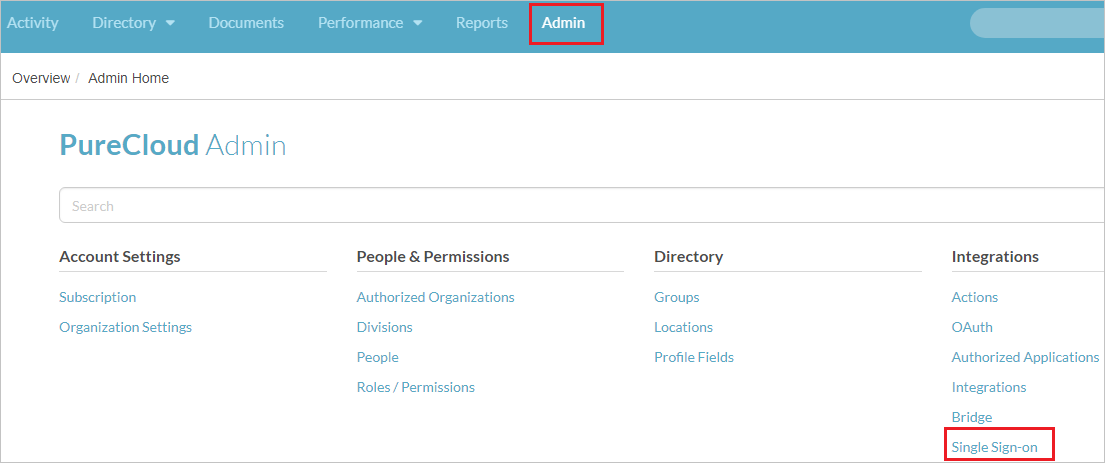
Switch to the ADFS/Azure AD(Premium) tab, and then follow these steps:
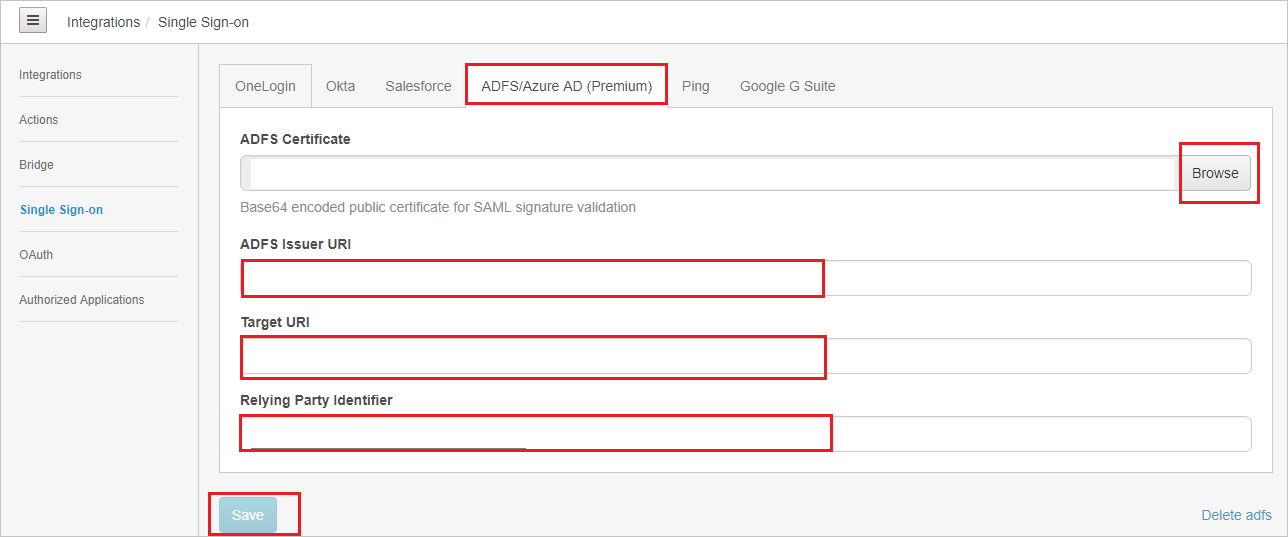
a. Select Browse to upload the base-64 encoded certificate that you downloaded into the ADFS Certificate.
b. In the ADFS Issuer URI box, paste the value of Microsoft Entra Identifier that you copied.
c. In the Target URI box, paste the value of Login URL that you copied.
d. For the Relying Party Identifier value, go to the Azure portal, and then on the Genesys Cloud for Azure application integration page, select the Properties tab and copy the Application ID value. Paste it into the Relying Party Identifier box.
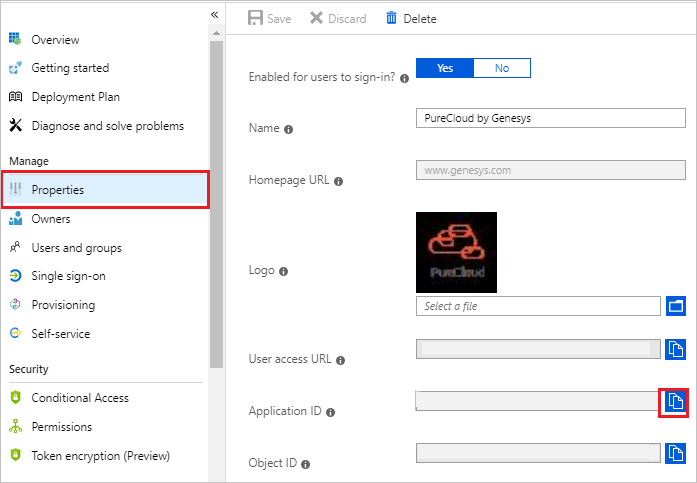
e. Select Save.
Create Genesys Cloud for Azure test user
To enable Microsoft Entra users to sign in to Genesys Cloud for Azure, they must be provisioned into Genesys Cloud for Azure. In Genesys Cloud for Azure, provisioning is a manual task.
To provision a user account, follow these steps:
Log in to Genesys Cloud for Azure as an administrator.
Select Admin at the top and go to People under People & Permissions.
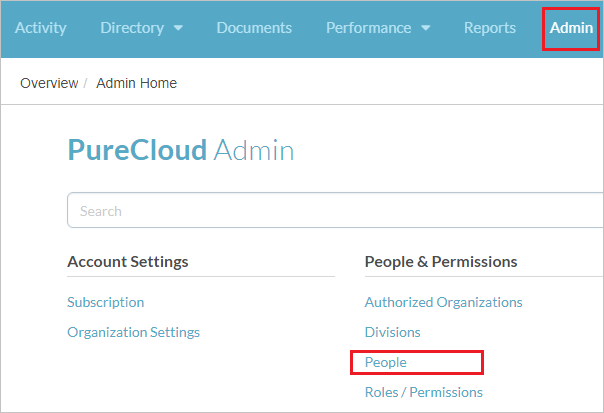
On the People page, select Add Person.

In the Add People to the Organization dialog box, follow these steps:
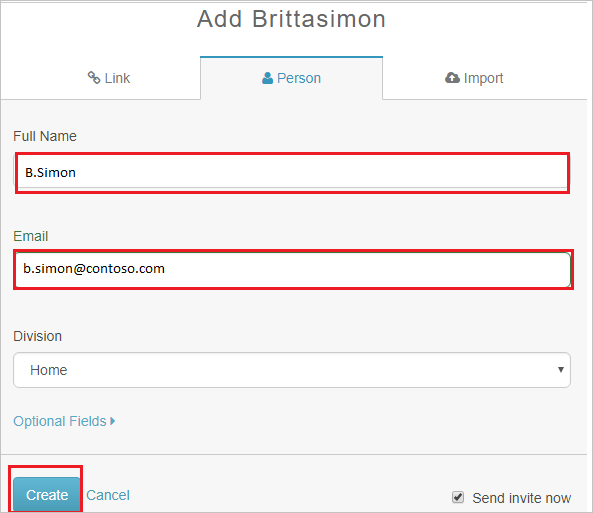
a. In the Full Name box, enter the name of a user. For example: B.simon.
b. In the Email box, enter the email of the user. For example: b.simon@contoso.com.
c. Select Create.
Note
Genesys Cloud for Azure also supports automatic user provisioning, you can find more details here on how to configure automatic user provisioning.
Test SSO
In this section, you test your Microsoft Entra single sign-on configuration with following options.
SP initiated:
Click on Test this application, this will redirect to Genesys Cloud for Azure Sign on URL where you can initiate the login flow.
Go to Genesys Cloud for Azure Sign-on URL directly and initiate the login flow from there.
IDP initiated:
- Click on Test this application, and you should be automatically signed in to the Genesys Cloud for Azure for which you set up the SSO.
You can also use Microsoft My Apps to test the application in any mode. When you click the Genesys Cloud for Azure tile in the My Apps, if configured in SP mode you would be redirected to the application sign on page for initiating the login flow and if configured in IDP mode, you should be automatically signed in to the Genesys Cloud for Azure for which you set up the SSO. For more information about the My Apps, see Introduction to the My Apps.
Next steps
Once you configure Genesys Cloud for Azure you can enforce session control, which protects exfiltration and infiltration of your organization’s sensitive data in real time. Session control extends from Conditional Access. Learn how to enforce session control with Microsoft Defender for Cloud Apps.